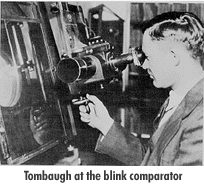The Blink ComparatorThe blink comparator is actually a microscope that optically superimposes two photographic plates, "blinking" between them so rapidly that the two plates look as one. This allows the researcher to compare the plates and look for any discrepancies between them. As the viewed image rapidly alternates between the two plates, the fixed stars merge together, since they hold their relative positions in the sky. But any object that moved in the sky between the times the photographs were taken shows up in different positions on the two plates. In the blink comparator, this object appears to jump back and forth, revealing itself to the careful eye. Each photograph that Clyde Tombaugh took contained an average of 160,000 stars, and those taken of the Milky Way region could hold up to a million tiny stars, one of which could be the sought-after planet. Tombaugh tackled this enormous task by dividing up the plates so he only had to blink a few hundred stars at a time. It took him up to a week to examine one pair of plates--tedious work that eventually paid off.
|
 Two
photographs of the same section of the sky are taken several days apart,
allowing time for any planetary body to move. To achieve the best results,
the plates have to be taken with the same exposure and in similar viewing
conditions. The photographs are developed and carefully positioned in
the blink comparator.
Two
photographs of the same section of the sky are taken several days apart,
allowing time for any planetary body to move. To achieve the best results,
the plates have to be taken with the same exposure and in similar viewing
conditions. The photographs are developed and carefully positioned in
the blink comparator.